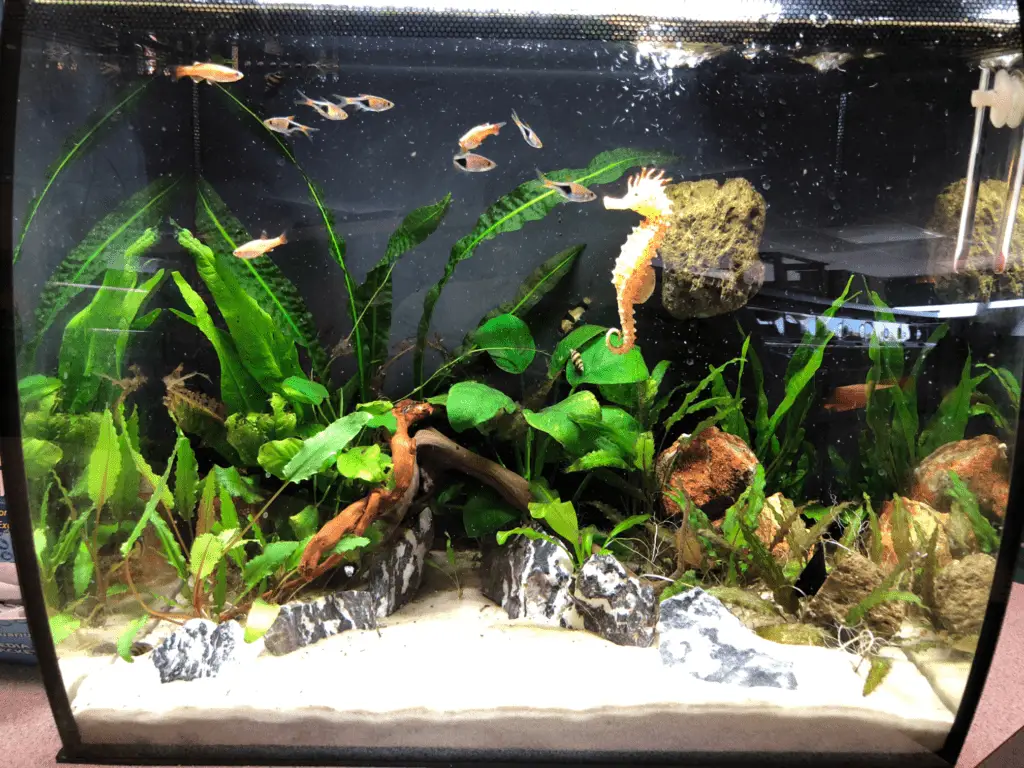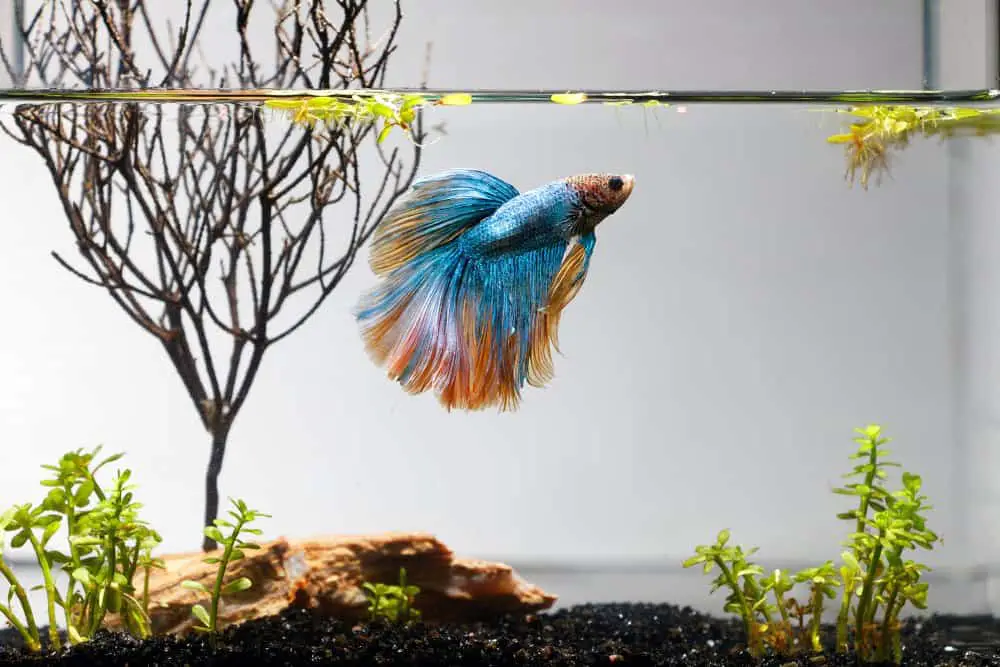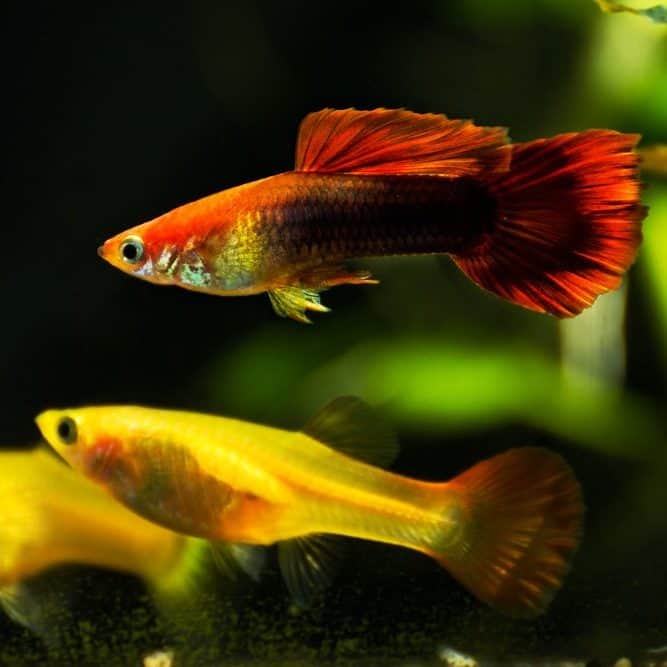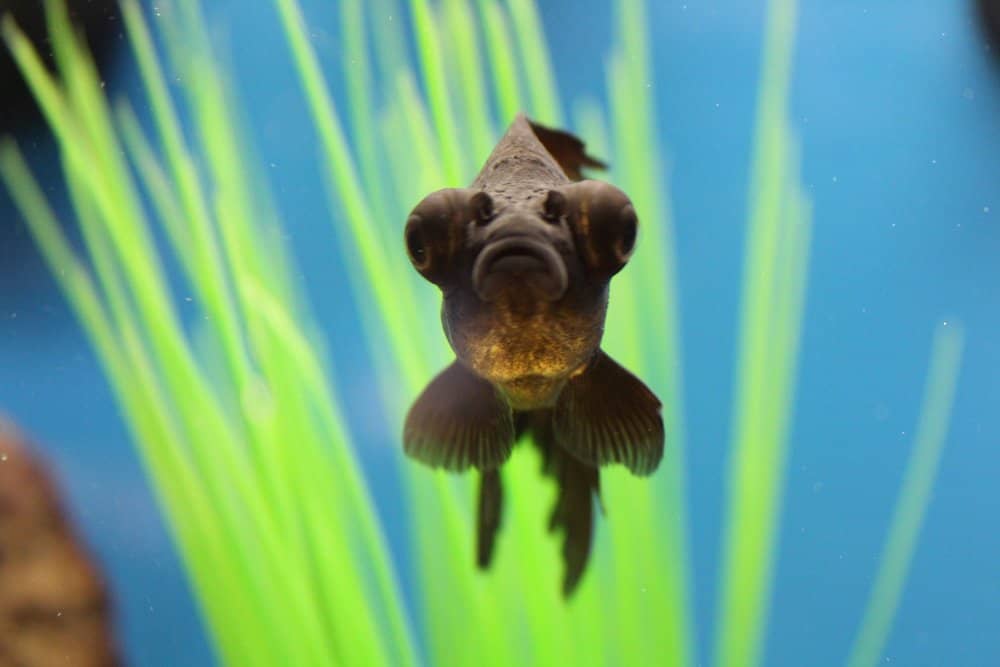Choosing a fish tank is one of the most important decisions you will make as a fish-keeper. Along with choosing suitable fish and giving them the proper care, buying the best fish tank is crucial to ensuring your fish survive and thrive.
How do you choose the right fish tank?
It might sound strange, but if you are a beginner fish-keeper, we recommend choosing the fish tank you are going to buy before deciding upon the fish you want to keep.
The reason for this is that most people have limited space to put a fish tank and a limited amount of money to spend on one. There’s no point deciding that you want to keep a certain type of fish, only to discover that you’d need a 70 gallon tank and you don’t have anywhere near enough space in your home.
To choose the right fish tank for you:
- Find a space in your home where you can put a fish tank (remember that you’ll need an electricity supply)
- Measure the space to see how wide, deep and tall your fish tank can be (remember to account for any cabinets or equipment and to leave enough room above the tank to open the lid for maintenance)
- Put those measurements into an aquarium size calculator to work out the size of your tank in litres or gallons (if using gallons, be careful not to mix up UK and US gallons, which are slightly different)
You can then start shopping for suitable fish tanks at that size or smaller.
You’ll find that there are lots of different fish tanks available. They come in various shapes, can be made from different materials, and some have a built in cabinet while others are standalone (so you’ll need to buy a separate stand for them).
If you have the choice between a long horizontal fish tank and a tall vertical fish tank, we strongly recommend choosing the wide horizontal option. Horizontal tanks have a larger surface area, which allows more oxygen into the water. We’ll talk more about this later.
Once you have decided on a size, check out our series of articles on the best fish tanks by volume from the list below:
- Best 2.5 and 3 gallon fish tanks for small spaces
- Best 5 gallon fish tanks for a freshwater beginner
- Best 10 gallon fish tanks and aquarium kits
- Best 20 gallon fish tanks
- Best 30 gallon fish tanks
- Best large volume fish tanks
Where should a fish tank be placed?
A fish tank should be placed in a location that:
- Has a nearby electricity supply to power equipment like your filter
- Doesn’t experience any large or sudden temperature changes
- Doesn’t experience any large or sudden changes in lighting
- Is quiet and doesn’t have lots of people walking closely past all the time
- Is unlikely to get bumped into by people or pets
- Gives you room to maintain your tank, such as doing water changes
- Doesn’t present any dangers should the water leak or spill out of the tank
- Won’t disturb you – for example, the noise of a filter could keep you awake if the fish tank is in your bedroom
- Is somewhere that you can view and enjoy your fish
Is it ok to put a fish tank near a window?
You should never put a fish tank near a window or in direct sunlight. Strong light will disturb most types of fish, particularly if it appears suddenly or varies significant over a short space of time. Placing a fish tank near a window will also cause large temperature fluctuations in the water.
Fish like their water temperatures and light levels to remain stable or change only slightly and gradually over a long period of time (such as a day/night cycle).
Placing a fish tank near a window means you lose control of temperature and light levels and you are likely to stress your fish. High stress levels can then cause your fish to become sick or even die.
What size fish tank should I get?
The size fish tank you should get is determined by how much space you have in your home.
Don’t decide which fish you want and then struggle to find space for a large enough tank (or worse, keep the fish in a tank that is too small for them). Instead, look at suitable locations to place a fish tank in your house, then calculate the size of fish tank that will fit in that area.
Once you have a suitable location and you know what size tank will fit, you can then research types of freshwater fish or saltwater fish that will go into that size tank.

What size fish tank is good for beginners?
The answer to the question “what size fish tank is good for beginners?” is actually quite surprising. You might assume that beginners should start with a small tank (say 5 gallons) before taking on the task of looking after a larger aquarium of say 20 or 30 gallons or more. However, the opposite is actually true! Larger fish tanks are easier to look after than smaller ones, so it’s actually best for a beginner to buy the biggest fish tank they can (within reason!).
The reason why big fish tanks are good for beginners is that they contain more water, and larger bodies of water will remain more stable in terms of temperature and other water parameters. There’s also more water to dilute any dangerous chemicals (such as ammonia). This can be useful, as beginner fish-keepers are quite likely to make mistakes when setting up their tank or with their water change schedule.
We recommend that beginners buy a fish tank that is at least 15 gallons – ideally 20 gallons or more – cycle it properly and take care not to add too many fish. This gives the beginner fish-keeper the best chance of benefiting from stable water conditions while they learn about the fish-keeping hobby.
What shape fish tank is best?
The best shape fish tank is the traditional horizontal rectangle design that you probably think of when you picture a fish tank.
Other shapes are available – including cubes, tall vertical rectangles, hexagons, and even spheres – but all of these are worse than the traditional design. The reason is that unusual shapes might look interesting to us, but they’re not as good for the fish.
There are two reasons why horizontal rectangles are the best fish tank shapes.
- They allow more oxygen into the water
- They give the fish room to swim
Let’s look at each of these reasons in more detail…
Like humans, fish need oxygen. The difference is that where we get oxygen from air, fish get oxygen from water. The water in your fish tank therefore needs to contain enough oxygen to allow your fish to breathe. This oxygen enters the water at the surface.
As the flow of water from your filter or air pump causes the surface of your fish tank water to ripple, oxygen is dissolved into the water. The more surface area there is, the more oxygen is absorbed into the water and the more oxygen your fish have to breathe.
The best shape fish tank is the horizontal rectangle, as this shape has the largest surface area, which allows more oxygen to be absorbed into the water and helps your fish to breathe. Avoid tall fish tanks and unusual shapes, as they will have smaller surface areas.
The second reason why wide horizontal tanks are better than vertical tanks is swimming space. Fish tend to like swimming around at a certain depth. Some like to swim near the top of the tank, others in the middle, and others near the bottom. A horizontal tank allows the fish to choose their level and swim horizontally from one side of the tank to the other. A vertical tank isn’t as wide, and fish don’t tend to like swimming vertically up and down, so your fish has less room to swim and explore.
What is the best fish tank to buy?
The best fish tank to buy is a fish tank that is the right size for your chosen location and for the fish you plan to keep. We recommend choosing a tank from a well-known, reputable brand, and for beginners we suggest buying a glass rather than an acrylic fish tank.
While glass fish tanks are heavier, they don’t scratch as easily as acrylic and they are much cheaper. Of course, the downside is that glass can crack more easily than acrylic, so you need to be extra careful.
When choosing the best fish tank for you, you’ll find lots of fish tanks sold as kits. This is personal preference, but we prefer buying the fish tank on its own, then adding our choice of equipment, plants and decorations, rather than having a kit choose for us. After all, kitting out your fish tank is part of the fun! However, kits can be a good choice to help beginners get started.
While the best fish tank to buy will vary depending on your circumstances, we highly recommend reviewing our various articles on the best fish tanks:
- Best 2.5 and 3 gallon fish tanks for small spaces
- Best 5 gallon fish tanks for a freshwater beginner
- Best 10 gallon fish tanks and aquarium kits
- Best 20 gallon fish tanks
- Best 30 gallon fish tanks
- Best large volume fish tanks
How much does a fish tank cost?
The price of a fish tank varies considerably depending on the size of tank, the material that it is made from, the brand, and any extras that may be included, such as filtration, lighting or a built-in stand.
It’s possible to pick up a decent sized fish tank for under $100, but you’ll then need to add a filter, lighting, decorations, and possibly other aquarium equipment such as heaters and air pumps. You’ll also need to buy a suitable stand and consumable products such as fish food and water treatments. Finally, a fish tank will add to your electricity bill too, as you’ll be paying to power the filter and other equipment.
Generally speaking, we’d suggest budgeting at least a few hundred dollars for a new home aquarium setup. If you’re on a budget then it’s a good idea to research what you need in advance and add up all the costs. You may also be able to make savings by buying used equipment.
How many fish can I have in my tank?
A popular rule of thumb is that you can have one inch of fish for every gallon of tank water. For example, you could have five two-inch fish in a 10 gallon tank. However, you need to be very careful when applying this rule and take it as a rough guide only.
To show how this rule can quickly break down, let’s take an extreme example. Above, we said you could have five two-inch fish in a 10 gallon tank, which seems reasonable. But what if you only had one fish? Going by the “one inch of fish per gallon” rule, that would mean you could have one ten-inch fish in a 10 gallon tank. A 10 gallon tank is probably only about 20 inches long… the fish would be half as long as its tank!
So, if you’re going to use the one inch of fish per gallon of water rule, it’s important to apply a few more rules at the same time:
- Only apply the rule to small, slim-bodied fish
- Remember that tank space is taken up by decorations, plants and equipment. Estimate and use the actual water volume, not the total size of the tank.
- Remember that fish will grow. Use the adult size of the fish in the calculation, not the size that they are now.
And finally, research the type of fish that you want to keep. Read about how much swimming space they need, how big they grow, and whether they should be kept in groups. This will help you sense-check your calculations and avoid over-stocking your tank.
How many fish can I have in a 5 gallon tank?
A 5 gallon tank is very small, so it can only hold a few small fish. We’d recommend keeping a single male better fish or a small school of 4 or 5 neon tetras in a 5 gallon tank.

How many fish can I have in a 10 gallon tank?
Using the rough rule of one inch of fish for each gallon, and allowing for some water volume to be taken up by other objects in the tank, you can fit around nine inches of fish in a 10 gallon tank.
We’d suggest a small group of 4 or 5 live breeders such as guppies, mollies or platies. Just be aware that they breed easily, so if you mix males and females then you could end up with more fish than you planned for!

How many fish can I have in a 20 gallon tank?
Once you get to a 20 gallon tank size, your options start to open up and there are a lot of different freshwater fish and saltwater fish that could live quite happily in a tank this size.
A 20 gallon tank is the minimum tank size that we would recommend for a goldfish. We’d therefore suggest keeping a single, slow-swimming fancy goldfish in your 20 gallon tank.

What happens if I have too many fish in my tank?
If you have too many fish in your fish tank then the water will become polluted by their waste. Even frequent water changes won’t be enough to stop this pollution from burning the fish’s fins and gills, making it increasingly difficult for them to breathe. The fish will most likely die quite quickly.
Any fish that do survive an overstocked tank will likely be stressed and injured by the experience. They will not grow to their full potential or live as long as they otherwise could.
Finally, if you have too many fish in your tank then they are more likely to fight for territory and food. This will also result in injury and death.
It is so important to avoid overstocking your tank, as it is far more pleasant to see fish grow and thrive than become stunted and live short painful lives.
How do you maintain a fish tank?
Maintaining a fish tank involves carrying out regular tests to monitor water conditions, keeping an eye on water parameters such as temperature, conducting regular water changes, cleaning algae from the sides of the tank, and feeding the fish.
If you set up your tank well and don’t add too many fish then you should be able to get into a regular maintenance routine. You will then only need to carry out extra maintenance – such as large water changes or adding medications and treatments to the tank – if your fish get sick or something throws off their water parameters.
Do you remove fish when cleaning a fish tank?
If at all possible, you should avoid removing fish when you clean a fish tank. Catching and removing fish can be very stressful for them, which lowers their immune system and increases the chance of them becoming sick. It’s also quite likely that you could injure a fish while trying to catch them.
It is far better to clean a tank calmly and slowly, in a way that doesn’t startle the fish, while they remain inside the tank, rather than attempting to remove them.
Is it easy to maintain a fish tank?
Once your fish tank is properly set up, stable and well cycled then you will find that maintenance is quite easy. In most cases, there are no more maintenance requirements than feeding, a weekly water change (only changing a third or less of the water each time), and occasional cleaning of algae on the tank walls.
Which fish tank is easiest to maintain?
The easiest fish tanks to maintain are often larger tanks, as they have more stable water parameters. With a small tank, you’ll find yourself having to do lots of large water changes to keep the water parameters under control, whereas a large tank can become very stable and low maintenance if set up well.
It’s also easiest to maintain a traditional horizontal rectangle tank, rather than unusual shapes or tall deep tanks where it can be difficult to reach the bottom.
What should I read next?
If you’d like to learn more, we recommend exploring our fish tank articles or finding out more about freshwater fish, saltwater fish, aquarium equipment, or aquarium plants.
